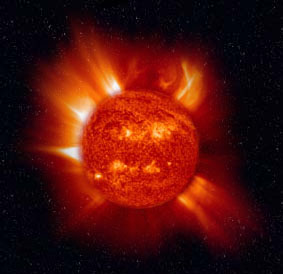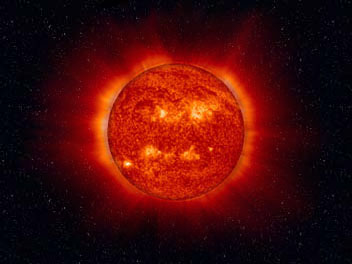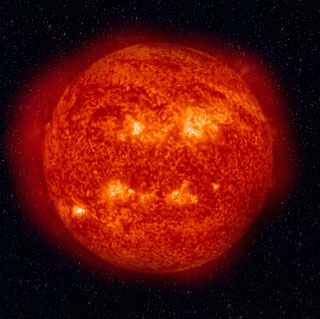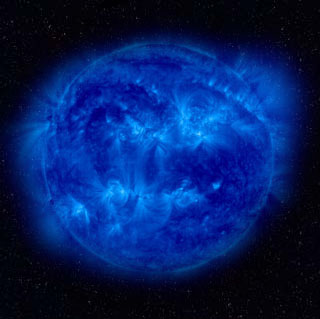
THE SUN
"Come and I shall tell thee first ofall the beginning of the sun and
the sources from which have
sprung all the things we now
behold -- the earth and the bil-
lowy sea, the damp vapor and the
titan air that binds his circle fast
round all things."
-Empedocles
5th Century BC Greek
The sun, sparkling jewel in the celestial crown, is actually a youngish, smallish, rather unspectacular star. Half the age of the Milky Way, it was born out of a cloud of gas a mere five billion years ago. It grew quickly into its familiar attributes, and can be expected to enjoy a protracted middle age in a relatively unchanged state before the beginning of it's eventual end. Though not a Hollywood star among stars, our sun is just that -- ours. Of all the stars in all the galaxies, it is, at a distance of 93 million miles, our closest one. The one around which our world revolves. The light of our lives.
Insignificant-within-the-perspective-of-all-space as it may be, the sun, sovereign of our sky, seems spectacularly large to us. With a diameter of 864,000 miles, it is 109.5 times the size of Earth. And, even though it's comprised of gas, it weighs two billion billion billion tons. Gravity on the surface of the sun is almost 28 times greater than here on Earth. This is like saying that if you could survive the intensity of a stroll on that astral oven, you would suddenly find yourself weighing two tons. The volume of the sun is 337,000 million million cubic miles, or 1,306,000 times that of Earth's. That's like what? A pea compared to a spaceship?
The chemical composition of the sun and the earth are similar. But there is no terrestrial comparison, our paltry attempts at nuclear combustion included, when it comes to producing power. Fathom this: the sun generates four hundred trillion trillion watts of energy every second. Enough energy to power 2,600 Earths, each one entirely filled with 200-watt light bulbs. Too many zeroes to comprehend.
The temperature at its core, the focal inferno, is speculated to be 25 million degrees Fahrenheit. The sun's surface churns, roils, boils away, stirring up 6000-degree heat bubbles the size of Pennsylvania. Its many-layered atmosphere surges to heights of 80,000 miles, and its corona reaches all the way to Mercury, 36 million miles away.
 "When it is hot I sweat alot.
"When it is hot I sweat alot.
When I sweat I feel the intense of
heat. Heat give off light. Light
give off energy. Energy is give off
of electricity. Electricity
give off shot. Shot and then you
get dead."
-Denise Baque
Grade 6 Queens, NY
The sun -- strongest, most potent of super numinous powers -- like us was born, lives, and shall one day die. In about five billion years it will start to expand, swell to become a red giant 166 times its present size, an inflatable hot air atomic oven which will radiate hugely increased heat. The ice caps on Earth will melt, the oceans will evaporate, the deserts prevail. Venus will sizzle and Mercury will be cooked to a crisp.
Ultimately, that solar forge, source of all energy, will slip into gradual decline and shrink down to what is called white dwarfdom, a cinder of its former fiery self. It will be a compressed black coal at its burnout 50 billion years from now, frizzled in its own furnace. Stone cold dead. And, even after its demise, Earth, though vastly changed and devoid of life as we know it, will continue its adoring circle dance, ringing the sun like the bride at a Hassidic wedding.
In archaic times, people perceived the sun, in its shining prime and glory, giver of heat and light and life, to be the effulgent force of the female, a passionate aspect of the Great Mother, the versatile Jill-of-all-Trades who issues forth and supports whole life. She was the Heaven-Illuminating Goddess, Ameratsu Omikame, in Japan, and the Queen of Heaven and Earth, Arinna, in Mesopotamia. She was Yhi, Sun Woman, to the Arunta of Australia. She was known in Antolia, Siberia and Native America.
Tribal northern Europe knew Her, too. The Germans called Her Sunna, as did the Norwegians. In Scandinavia, She was Glory-of-Elves, or Sol. The Eddas say that on Doomsday, She will bear a daughter who will be the new sun, the next creation, the luminous world to come. She was Sol, as well, to the Celts who also called her Sul or Sulis. Her celebrations took place on hilltops overlooking springs. A major ceremonial site was Silbury Hill (Sulisbury Hill) adjacent to the springs at Bath, once called Aquae Sulis. The Romans dedicated altars at Bath, sacred to Sul Minerva.
The Great Mother in ancient India was Aditi, the mother of the 12 spirits of the zodiac, the Adityas who would "reveal their light at Doomsday". The Mahanir- vanatantra describes the sun as a golden garment of light which graces the Great Goddess. "The sun, the most glorious symbol in the physical world, is the mayik vesture of Her who is `clothed with the sun.'"
 "I praise the disc of the rising sun,
"I praise the disc of the rising sun,
Red as a parrot's beak,
sharp-rayed, Friend of the lotus
grove, An earring for the Goddess
of the East."
-Vidya Kara
11th Century Sanskrit
Tantric Buddhist monks greeted the Sun Goddess, Marici, at dawn, chanting to Her, "the glorious one, the sun of happiness...I salute you O Goddess Marici! Bless me and fulfill my desires. Protect me, O Goddess, from all the eight fears." Marici, or Mari, was a precursor of the Christian Mary. The New Testament Book of Revelation, like the Mahanirvanatantra, refers to Her as a "woman clothed in the sun." Some early Christian mystics gazed upon the sun, the shining shawl which encircles Our Lady's shoulders, until they "became blinded by the light." It was understood that once having contemplated such brilliance, there was nothing left worthy of being seen. The success of this practice seems to have been a sure path to sainthood.
The goddess was not always the sun personified herself, but often the force behind it. She was the controller of the cosmos, the sun and the celestial cycles. According to Greek mythology, Leto laid an egg which produced two offspring, the sun and the moon, Apollo and Artemis. The Egyptian Goddess, Hathor, hatched the "golden egg of the sun" at the dawn of creation. The Sun God, Osiris-Ra, died each night to return to the womb of the Great Mother, from whose "gate" he was reborn each morning. The same is said of the Maori Sun God, who must descend into the uterine cave of the Waters of Life in order to be regenerated daily.
With the advent of the patriarchy, the sun underwent a sex change. Profound, this gender shift was a portrayal of the left brain revolution, the ascendance of rationality over passion. Female divinity was overthrown, `overthroned', overgrown -- Her domain plundered, Her authority usurped, Her worship polluted. The sun, with the strength of its brilliance, its sheer presence and potency, came to stand for the masculine principle, the power of rational thinking. The moon, reflective, more subtle and seemingly erratic, came to be associated with the feminine in most cultures. Although the traits of the sun are thought to be male, it retains its female designation in the languages of Northern Europe, Arabia and Japan.
 "There is no sensible thing in all
"There is no sensible thing in all
the world more worthy to be an
image of God than the sun, which
with its sensible light illumines first
itself, and then all celestial and ele-
mentary bodies; so God first illu-
mines Himself with intellectual
light, and then the celestial and
other Intelligences."
-Dante
13th-Century Italian
In Mesopotamian mythology, the Hittite Sun Goddess, Estan, evolved into Istanu, a male Sun God. In pre-Islamic Arabia, The Sun Goddess was known as Torch of the Gods, Atthar or Al-llat. She was honored daily by pouring libations at rooftop altars. Her name was subsequently masculinized to Allah. Her other name, Shams, along with her attributes, became associated with a male sun god, Shams-On. The Babylonian Sun God was Shamash, clearly related. The Hebrew word for sun, as well as the biblical character, Samson, were also derived from Her name.
The source of Samson's masculine strength is his long ray-like hair, which is symbolic of the sun. Other solar heroes, Apollo Chrysocomes (He of the Golden Locks) and Heracles also wore streaming, gleaming tresses. Hathor, who birthed the sun, was depicted as the wild, lion-maned sphinx. Wasn't it Dolly Parton who said, "The higher the hair, the closer to God"?
Christ eventually became assimilated with other, older solar deities. There are many references which image Him as the sun. Malachi, the Old Testament prophet, speaks as an oracle from God, "But for you who fear my name, the sun of righteousness shall rise with healing in his wings." This was taken by the early Christians as a reference to the coming of Christ. Zacharia, father of Saint John the Baptist, foretold His birth: "God . . . will send down to us the visit of the rising sun in order to illuminate those who are in the darkness and the shadow of death." Like Greek and Roman temples, the first churches were built with Eastern oriented facades, and worshippers faced the East, the direction of the rising sun, while praying.
Celestially Auspicious Occasions
Because the sun is always predictable, invincibly there (in temperate and tropical climates, that is), it was deemed to be all seeing, all knowing, all powerful. An eye is the symbolic expression of this concept. Several African tribes regard the sun as the eye of the supreme deity. The Samoyeds of the Arctic see the sun and moon as the eyes of heaven. Sulis, the name of the old Teutonic Sun Goddess, comes from suil which means "the sun's eye." In India, the Sun God Sûrya, is the eye of Varuna, the God of the Heavens. In Greece, the sun, Helios, is the eye of Zeus; in Egypt, the eye of Ra; in northern Europe, the eye of Odin; in Oceania, the eye of Atea; and in Islam, the eye of Allah.
 "Thou eye of the Great God
"Thou eye of the Great God
Thou eye of the God of Glory
Thou eye of the King of creation
Thou eye of the Light of the living
Pouring on us at each time
Pouring on us gently, generously
Glory to thee thou glorious sun
Glory to thee thou Face of the God
of life."
-Gaelic Song To The Sun
Ortha nan Gaidheal
Since it determines both the cycle of the day and the circle of the seasonal year, the sun provides the structure of our existence, the framework within which our world revolves. As such, it seems to suggest all celestial and earthly order. Due to its dependability, the sun stands for authority. Law and Order. The sun, Ra, sailed through the skies accompanied by the Goddess, Maat, the embodiment of sunlight and the rightness of things, the natural order. Cosmic mandate.
Civil law is an extrapolation of the structured order of the universe. Hammarabi, who in the 18th Century B.C. codified Babylonian law, is always pictured standing on a stone column inscribed with the Code of the king. He is facing Shamash, the sun, in Whom justice dwells. It is He who has sent down the law. Shamash was known as "great judge of heaven and earth" and His Sun Temple was "the house of the judge of the world." Varuna was the guardian of the cosmic laws in Vedic India. He measured earth, sky and air and cast the four directions. Suryâ, the sun, acted as his calipers.
While the sun is the seat of celestial order, organized government is the center of civic order. Sovereignty is established by the authority of the ruler of heaven. Royalty traditionally traces its lineage and aristocratic entitlement to the sun. Divine right. The sun was the golden ancestor of the imperial families of ancient Egypt, India, Peru and Mexico. The High Chief of the Chumash of old California was called paha, "Image of the Sun." The priest-chief who ruled the lower Mississippi Natchez theocracy was the earthly representative of the sun.
"Honour the King, the Eternal, in
your bodies; resort unto the Lord
in your hearts. For he is
Understanding and knoweth the
secrets of the heart, his eyes
search out all men. He is the Sun
by which all mankind sees. He illu-
minates the Two Lands more than
the sun."-Egyptian traditional
The emperor of Japan has always asserted descent from the Sun Goddess, Ameratsu Omikame. In 1946, the American occupation demanded that the emperor abolish the state religion and abdicate his own divine standing. He complied. Nonetheless, twice each year he continues to don the mantle of his inherited role of sun priest and prays for the well-being of his people in great ceremonies held at the summer and winter solstices. Official solar symbolism has also prevailed and the red sun still blazes in the center of the Japanese flag proclaiming "The Land of the Rising Sun".
In Europe, too, kings and queens have claimed kinship to the cosmos. The first Christian emperor, Constantine I, was a sun worshipper. His coinage carried its radiant countenance along with a dedication to "the invincible sun, my guardian." In 17th Century France, Louis XIV, "the Sun King," surrounded his court in solar imagery and gilded it in pure gold of the sun as pronouncement of royal alliance with the Powers That Be. When Queen Elizabeth II of England was coronated in 1952, she wore a golden gown beneath her ceremonial robe. The officiating Archbishop prayed that her throne "may stand fast in righteousness forevermore, like the sun before her and as the faithful witness in heaven."
Although the sun has been venerated to some degree in practically every culture in the world, a highly developed worship of the sun is comparatively rare. Solar cults flourished only in civilizations with vast civil structures and intricate political establishments organized around a central source of absolute imperial authority. In these societies, social order revolved around the priest-king-chief in the same way that the earth revolves around the sun.
The Egyptians created the earliest and most elaborate of the sun cults. Sometime in the fourth millennium BCE, the moon calendar was discarded in favor of solar time telling. Gradually, the pantheon of local gods gained sun-like qualities and eventually coalesced into a supreme solar deity, Ra, whose worship was centered in Heliopolis in Lower Egypt. Through the pharaoh, His son, He ruled the world as He ruled the heavens. The order and rule of government, of society, indeed, life itself, was deemed a direct inheritance from the sun. Divine dynasty. Solar symbolism is pervasive in Egyptian art, architecture and literature.
According to the records of the Spanish conquistadors, the Inca rule of Peru was one of the most organized and orderly regimes in the world. By the time of the European occupation, their empire reigned from Ecuador to northern Chile. All political, social and religious organization was focused upon the Sun Temple in the center of Cuzco, the capital. The Inca considered themselves "children of the Sun," whom they revered as Inti. The Palace of Gold, the shrine in honor of Inti, the Sun from whom all riches flow, was lavishly decorated with that solar metal. It was situated so that each morning the rising sun would strike a gold-cast solar disc and bathe the entire interior with reflected yellow light.
The Aztec civilization of Mexico evolved into a solar monotheism as it became increasingly stable and affluent. Their ancestral tribal god, Huitzilopochtli, grew in influence and prominence and developed solar dimensions, as if to legitimatize their rule. The famous Aztec calendar, the "stone of the sun," diagrams the cosmology of the culture. In the center is the sun, Tonatiuh, "He Who Goes Forth Shining". He is depicted as a bloodthirsty fellow, His great tongue stretched out to receive the ever flowing "precious waters," the blood sacrifice, which He demands in payment for the great gifts which He bestows upon the world. The literal life blood of the community offered in exchange for energy. As it is the job of the sun to uphold the structure of the universe, it was the responsibility of the emperor to ensure that the world works well. To that end, Tonatiuh had to be properly propitiated.
Today we still offer ourselves up, well-oiled, on the altar of the sun. A rather snide sort of sacrament for such impudent adolescents to make. We have disdainfully rejected the gift of the sun's energy, freely given, and have instead overstepped our species imperative in our clumsy attempts to emulate holy conflagration. And we have burnt our fingers in the process. But perhaps, just perhaps, before we burn the house down around us, we can learn, like any little child, not to play with fire.
-Havasupai Prayer to the Sun "Sun, my relative, be good coming out.
"Sun, my relative, be good coming out.
Do something good for us. Make me work,
So I can do any thing I wish in the garden.
I hoe, I plant corn, I irrigate. You, sun, be
good going down at sunset. We lie down to sleep.
I want to feel good. While I sleep, you come up.
Go on your course many times. Make good
things for us men. Make me always the same as I am now."
MAMA DONNA'S TEA GARDEN AND HEALING HAVEN
OLD PS9
PO Box 380403
Exotic Brooklyn, NY 11238-0403
718-857-2247
